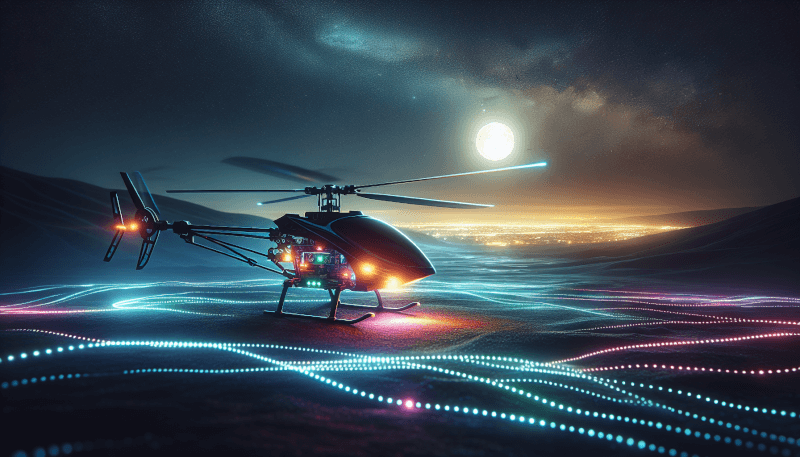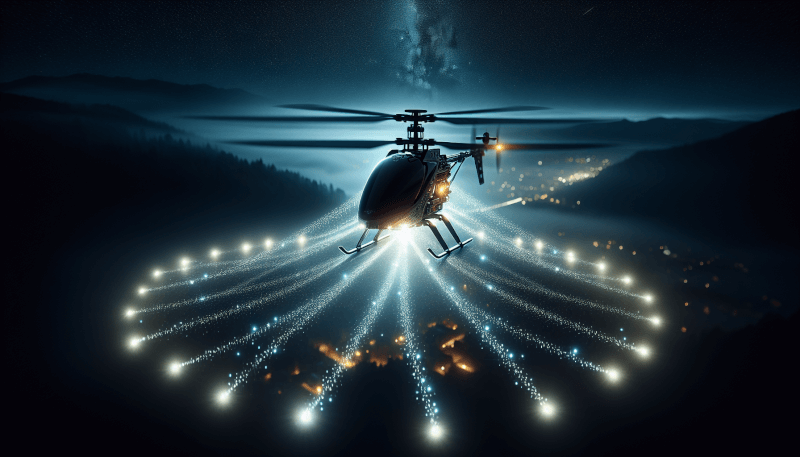Are you an avid RC helicopter enthusiast looking to add some excitement to your flying experience? Look no further! This article has got you covered with some valuable tips on how to fly your RC heli at night using LED lights. Whether you’re a beginner or a seasoned flyer, these tips will help you navigate the dark skies with confidence, creating a captivating visual spectacle for yourself and others to enjoy. So grab your RC heli and let’s take to the night skies together with these illuminating tips!

Selecting the Right LED Lights
When it comes to flying your RC helicopter at night, selecting the right LED lights is crucial. One of the most important factors to consider is the brightness of the lights. You want lights that are bright enough to provide sufficient illumination, but not so bright that they overwhelm your visibility or cause distractions. Look for LED lights that offer adjustable brightness settings, allowing you to customize the lighting to your liking.
In addition to brightness, it’s important to consider the color options available. Different colors can have different effects and visibility in different lighting conditions. For example, red lights tend to have a longer wavelength and can be seen from a greater distance, while white lights provide a more diffused and even illumination. Consider the specific needs of your RC helicopter and choose LED lights that have color options suitable for your desired effect.
Another important consideration when selecting LED lights is whether they have adjustable settings. Lights with adjustable settings allow you to tweak the brightness, color, and even the flashing patterns, giving you more control over the overall look and visibility of your RC helicopter. This flexibility can be particularly useful if you plan on using your helicopter for different purposes or in various environments.
Finally, it’s crucial to ensure that the LED lights you choose are suitable for outdoor use. Some LED lights are designed specifically for indoor use, and using them outdoors could result in damage or malfunction. Look for lights that are specifically labeled as waterproof or weatherproof to ensure they can withstand the conditions you’ll be flying in. This will help protect your investment and ensure that your LED lights perform reliably.
Properly Mounting the LED Lights
Once you have selected the right LED lights for your RC helicopter, it’s important to properly mount them to ensure they stay secure during flight. The last thing you want is for your lights to come loose or move around, which can not only be distracting but also potentially dangerous.
To securely attach the lights, it’s recommended to use adhesive or zip ties. Adhesive can be applied to the back of the lights and then stuck to the helicopter’s body or frame. Make sure to clean the mounting surface thoroughly before applying the adhesive for better adhesion. Alternatively, zip ties can be tightly fastened around the lights and the helicopter’s frame, ensuring a stable mounting.
When positioning the lights, consider strategic placement for optimal visibility. Place lights in areas that provide good illumination and are visible from different angles. This can help enhance the visibility of your RC helicopter in the dark and make it easier for you to see its orientation during flight.
However, it’s important to ensure that the lights do not interfere with the helicopter’s airflow. Poor placement of the lights can disrupt the airflow around the helicopter, potentially affecting its stability and maneuverability. Be mindful of the placement and make necessary adjustments to optimize both visibility and flight performance.
Synchronizing the LED Lights
For a truly impressive display in the night sky, consider using synchronized or programmable LED lights. These lights can be synced with the movements of your RC helicopter, creating stunning visual effects that are synchronized with your flying maneuvers.
When using synchronized LED lights, it’s important to ensure that they are properly synchronized with the helicopter’s movements. This will require setting up the lights according to the instructions provided by the manufacturer. Make sure to follow the recommended timing and synchronization process to achieve the desired effects.
Some LED lights come with pre-installed lighting patterns, allowing you to easily switch between different patterns. Alternatively, you can program your own lighting patterns if the lights offer programmable features. Experimenting with different patterns and effects can add an extra level of creativity and excitement to your night flights.
Consideration of Battery Life
Flying your RC helicopter at night requires considering the battery life of both the helicopter and the LED lights. To optimize the battery life, it is highly recommended to choose energy-efficient LED lights. LED lights are known for their energy efficiency, allowing you to enjoy longer flights without draining the battery quickly.
When selecting LED lights, check the battery capacity and estimated usage time provided by the manufacturer. This will give you a good idea of how long the lights can be used before requiring a battery recharge or replacement. It’s always better to have a clear understanding of the battery life to plan your night flying sessions accordingly.
Carrying spare batteries is another smart move to extend your flight time. Having extra batteries on hand will allow you to quickly replace drained batteries and continue flying your RC helicopter. This is especially helpful if you plan on engaging in longer night flights or if you don’t have immediate access to a charging source.
To ensure better longevity of your battery, it’s generally advised to avoid draining it completely. Lithium batteries, commonly used in RC helicopters, tend to have a longer lifespan when regularly charged and discharged partially rather than being fully depleted. Aim to recharge your battery before it reaches its minimum voltage level for prolonged battery health.

Flight Safety Precautions
Flying your RC helicopter at night adds an extra dimension of challenge and excitement. However, it’s important to prioritize safety and take certain precautions to minimize risks and protect yourself and others around you.
First and foremost, choose a well-lit and open area for your night flights. Adequate lighting will ensure better visibility of both your RC helicopter and its surrounding environment, reducing the chances of accidents or collisions. Avoid areas with poor visibility, such as dimly lit parks or areas with dense vegetation.
Maintaining a safe distance from obstacles or people is crucial for flight safety. Remember that your RC helicopter can be hard to see in the dark, both for yourself and others. Maintain a reasonable distance from buildings, trees, power lines, and any other potential obstacles. Additionally, be mindful of the presence of people around you and avoid flying too close to them, as accidents can quickly occur.
Always be aware of the orientation and flight path of your RC helicopter. Flying at night can make it harder to visually track your helicopter, so it’s important to stay focused and maintain control. Keep an eye on the direction your helicopter is facing and ensure that it is flying in the intended path. This will prevent unintended collisions and enhance your overall flying experience.
Lastly, avoid flying your RC helicopter too high or out of sight. It can be tempting to push the limits and test the capabilities of your helicopter at night, but doing so can lead to unpredictable situations and potential loss of control. Always keep your helicopter within your line of sight and maintain a reasonable altitude for safer and more enjoyable flights.
Mastering Orientation
When flying your RC helicopter at night, it’s essential to have a clear distinction between the front and back lights. This will help you maintain orientation and ensure you’re flying in the desired direction.
Using different colors for the front and back lights is an effective way to differentiate between the two ends of your helicopter. For example, you can use red lights for the back and white lights for the front. This color scheme provides a clear visual reference, even in the dark, allowing you to easily determine the orientation of your helicopter.
Practice flying in different orientations during daylight before attempting night flights. This will help you become more comfortable and familiar with the controls and movements of your RC helicopter. Start by practicing basic maneuvers, such as hovering, forward flight, and turns, and gradually progress to more advanced maneuvers as your skills improve. This will ensure that you have good control and minimize mistakes when flying at night.

Adjusting Transmitter Settings
To enhance visibility and make flying at night easier, it’s important to adjust the settings of your transmitter. The transmitter is the device you use to control your RC helicopter, and optimizing its settings can greatly improve your overall flying experience.
Increasing the brightness of the screen or the backlit display on your transmitter can make it easier to see the controls and read important information even in low light conditions. This will help you maintain better control and prevent accidental mistakes.
If your transmitter has a night mode or contrast adjustment feature, consider utilizing it. Night mode generally reduces the overall brightness and adjusts the colors to be more suitable for low light conditions. Alternatively, adjusting the contrast can help make the information on the screen more visible against the background.
Familiarize yourself with the controls of your transmitter in low light conditions. This will prevent fumbling around and making mistakes during night flights, as you’ll be more comfortable and confident with the buttons and switches on your transmitter. Take the time to understand the layout and function of the controls specifically for night-time operation.
Customizing the controls on your transmitter can also be helpful for easier night-time operation. Some transmitters allow you to assign specific functions to different buttons or switches, allowing you to tailor the controls to your preferences. Experiment with different configurations and find what works best for you.
Using Additional Lighting Aids
In addition to LED lights on your RC helicopter, there are other lighting aids you can utilize to improve visibility and orientation during night flights.
Using a headlamp can assist with visibility while controlling your RC helicopter. A headlamp provides a hands-free lighting solution, allowing you to focus on controlling your helicopter without the need to hold a separate flashlight. Choose a headlamp with adjustable brightness levels to suit your needs.
Attaching glow sticks to the rotor blades of your helicopter can create an interesting and eye-catching visual effect. Glow sticks are lightweight and can be easily attached using adhesive tape or zip ties. They provide additional illumination and make your helicopter more visible as the rotor blades spin.
Consider adding LED light strips to the landing skids of your RC helicopter. These light strips can help you see the landing area more clearly, especially in darker environments. They also add a stylish touch to your helicopter, making it look even more impressive during night flights.
Utilizing spotlights or ground lights in the flying area can significantly improve orientation. By placing spotlights or ground lights strategically, you can create reference points to better judge the altitude, distance, and flight path of your helicopter. These additional lights can provide additional illumination and serve as visual markers, making your night flights safer and more enjoyable.

Practice and Skill Development
Flying your RC helicopter at night requires practice and skill development to ensure safe and enjoyable flights. By following a few key tips, you can improve your flying abilities and become a proficient night flyer.
Start with basic maneuvers and gradually progress to more advanced ones. Mastering basic maneuvers such as hovering, forward flight, and turning is essential to build a strong foundation for night flying. As you become more comfortable and confident with these maneuvers, you can start exploring more challenging flights and maneuvers.
Practice flying in different weather conditions and wind speeds. Various weather conditions and wind speeds can affect the flight characteristics of your RC helicopter, particularly at night when visibility is reduced. By practicing in different conditions, you’ll become more experienced and better equipped to handle varying challenges.
Improving your reaction time and control precision is crucial for successful night flights. Nighttime flying requires quicker reflexes and precise control inputs due to reduced visibility. Regular practice and focused training sessions can help develop these skills and allow you to navigate your RC helicopter confidently in the dark.
Participating in night flying events or joining a local RC heli club can greatly enhance your skill development. These events and clubs offer opportunities to learn from experienced flyers, share tips and tricks, and gain exposure to different flying styles and techniques. Plus, they provide a supportive and enthusiastic community of fellow RC helicopter enthusiasts.
Maintenance and Care
Regular maintenance and care for your RC helicopter and LED lights are essential for optimal performance and longevity. Follow these maintenance tips to keep your equipment in top shape.
Regularly inspect and clean your LED lights. Dust, dirt, and other debris can accumulate on the lights, reducing their brightness and overall performance. Use a soft cloth or a small brush to gently clean the lights and remove any dirt or grime. Avoid using harsh chemicals or abrasive materials that can damage the lights.
Check for any loose connections or damage to the LED lights. Frequently inspect the wires, connectors, and mounting points to ensure they are securely attached and in good condition. Loose connections can cause flickering lights or intermittent operation, while damage may require replacing the lights altogether to maintain optimal performance.
Store your RC helicopter and LED lights in a safe and dry place. Moisture can damage both your helicopter and the lights, so it’s important to store them in a dry environment. Use a dedicated storage case or box to protect them from dust, moisture, and potential accidental damage. Proper storage will prolong the lifespan of your equipment and ensure it’s ready for the next night flying adventure.
Promptly replace any malfunctioning LED lights. If you notice any lights not functioning properly, such as inconsistent brightness or complete failure, it’s important to replace them as soon as possible. Using malfunctioning lights can affect the overall performance of your RC helicopter and compromise visibility and safety during night flights.



